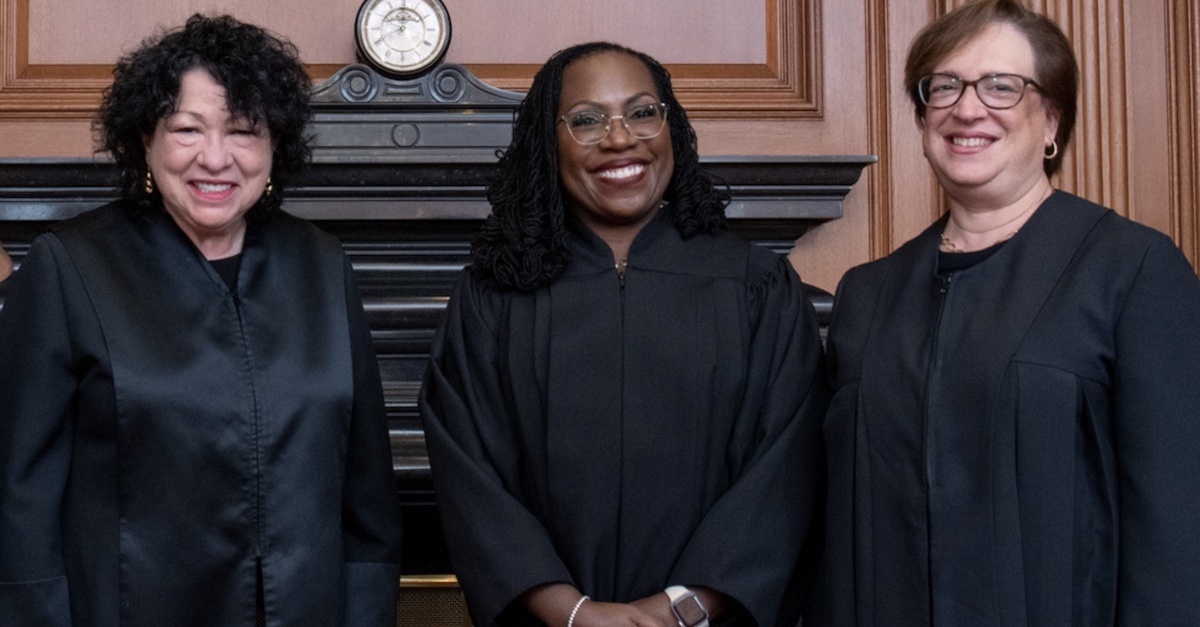
Justices Sonia Sotomayor, Ketanji Brown Jackson, and Elena Kagan Jackson. (Collection of the Supreme Court of the United States)
While the U.S. Supreme Court technically ruled unanimously in former President Donald Trump’s favor in order to keep him on the 2024 ballot, what might be called a “technical glitch” suggests the court’s liberal minority — the three justices appointed by Democratic presidents — were initially poised to dissent.
In a per curiam opinion, the nine justices agreed the Colorado Supreme Court overstepped its bounds and intruded on federalism principles by invoking Section 3 of the 14th Amendment to kick the 45th president off the Mile High State’s 2024 GOP primary ballot.
The majority opinion is, perforce, unsigned; its signatories not at all in doubt. Two concurrences signed by the court’s four women offer some mild to moderate criticism of the legal analysis used by the five men in the majority. But the concurrence penned by the court’s more liberal members contains a secret passage that clues court-watchers into how the decision-making process might have unfolded at One First Street.
The existence of this hidden text was first reported by Slate senior writer Mark Joseph Stern on X (formerly Twitter).
At the top of each page of Justice Sonia Sotomayor’s six-page concurrence is a bit of Supreme Court boilerplate reading: “SOTOMAYOR, KAGAN, and JACKSON, JJ., concurring in judgment.”
But on the first page of the concurrence, the passage’s metadata reads: “SOTOMAYOR, J., concurring in part and dissenting in part.”
The secret passage is accessed by double-clicking (if using Windows) or triple-clicking (if using the Mac OS) the first iteration of the passage, copying, then pasting into a word processor. The metadata for the later iterations of the passage on pages two through six offer a less substantive change. They use the phrase “the judgment.”
Searching the document for the term “dissent” registers three hits: two of which are for actual instances of the word “dissent” — while the third hit oddly highlights the word “concurring.”
An inspection of the HTML also shows the phrase “concurring in part and dissenting in part” is still extant in the PDF file of the opinion.
The discovery prompted numerous responses on social media chiding the justices (and/or their staff) for an apparent lack of computer skills — with some questioning what such mistakes might mean for computer cases of significant difficulty and distinction.
Other responses mused about if and how Chief Justice John Roberts was able to quell the small rebellion and turn the would-be dissent into a significantly less-grumbling-seeming concurrence.
In the concurrence, Sotomayor — who is joined by Justices Elena Kagan and Ketanji Brown Jackson — complains the majority “opines on which federal actors can enforce Section 3, and how they must do so” while reaching the same conclusion about Trump’s ballot access.
“We cannot join an opinion that decides momentous and difficult issues unnecessarily, and we therefore concur only in the judgment,” the concurrence reads.
The likely late-in-time metadata changes, however, reveal that Sotomayor, at least, may have initially been inclined to stylize her dispute with the majority as a dissent — though the outcome for Trump in the case, a marked win, would have been the same no matter what.
Have a tip we should know? [email protected]

